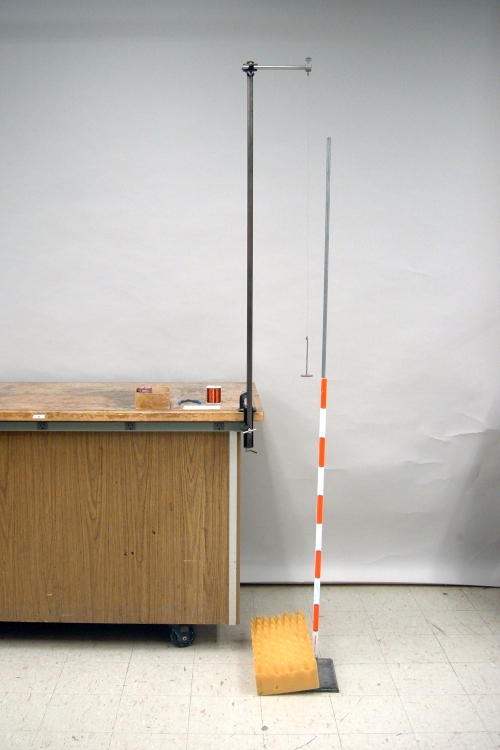
An 85-centimeter length of 34-AWG (0.160-mm-dia.) copper wire hangs from a hook, with a 50-g mass hanger attached to the other end. As you gradually add masses to the hanger, the wire stretches. It does not stretch far before it reaches its elastic limit, and can stretch by as much as 25 or 30 cm before it reaches its breaking point. The foam block protects the mass hanger from damage when it and the masses come crashing to the floor.
The mass hanger pulls downward on the bottom end of the wire with a force whose magnitude is mg, where m is the mass (50 g for the empty hanger), and g is the acceleration of gravity. The hook to which the top end of the wire is attached, along with the rod assembly, exerts an equal and opposite force on the top end of the wire. Since all parts of the wire are in equilibrium, at any point along it, the top part of the wire is pulling upward with a force of mg, and the bottom part is pulling downward with a force of mg. The wire is thus in tension; the force on it is a tensive force. A force that when applied to an object could deform it, is called a stress. The force applied to the wire in this demonstration is a tensile stress. The wire bears this force over its cross-sectional area (0.0201 mm2, 2.01 × 10-4 cm2 or 2.01 × 10-8 m2 for the 34-AWG wire), and since the force is perpendicular to the cross section of the wire, it is a normal stress. This stress is expressed as force per unit area (F/A).
When a stress is applied to a piece of material, the material undergoes a corresponding deformation, or strain. Under a tensile stress, the material stretches. (In the case of a compressive stress, it contracts.) Initially, the amount by which it stretches is proportional to the applied force. That is, the material obeys Hooke’s Law, which is expressed by the equation F = -kx, where k is a constant and x is the change in length of the material. (See, for example, demonstration 40.12 – Mass-springs with different spring constants and masses.) Strain is expressed as a proportion to the original length of the material; strain = (l - l0)/l0, or Δl/l0, where l0 is the original length of the material, and l is the length of the material under stress. The ratio of the applied force per unit area, to the deformation, the stress divided by the strain, is (F/A)/(Δl/l0). This quantity is called the Young’s modulus of the material, and is usually denoted Y. (In engineering contexts it is usually denoted E, and called the modulus of elasticity or elastic modulus.) If we take Y = (F/A)/(Δl/l0) and rearrange it, we can write Hooke’s law as F = (YA/l0)Δl, where k = (YA/l0) and x = Δl.
The range over which the material obeys Hooke’s law is called the proportional region. Over this range, if the stress is removed, the material returns to its original length. If the material is stretched past a certain point, it no longer returns to its original length when the stress is removed, but instead undergoes permanent deformation; it takes a set. The point at which this happens is called the elastic limit of the material. Past this point, the material continues to stretch, but the amount by which it does so is not linear with the applied force, and as noted above, the material remains permanently deformed. For many materials, Hooke’s law holds almost up to the elastic limit. (If the elastic limit is past the end of the proportional region, then between the proportional region and the elastic limit the material is not permanently deformed, but the deformation is not linearly related to the tension.) The elastic limit is also known as the yield point, and the stress at which it occurs is called the yield strength. There is some difficulty in determining exactly where this point is. Therefore, one usually specifies some small amount of permanent deformation, for example <0.2%, and takes the stress that causes it as the yield strength.
As the material is stretched further, it eventually reaches a point at which it can no longer sustain the tension, and it breaks. This point is often called the breaking point, and the stress that causes the material to break is called the ultimate strength of the material.
As noted above, the wire in this demonstration does not stretch very far before it reaches its elastic limit. The cross-sectional area of the wire is not perfectly uniform, so both the breaking stress and the strain at which the wire breaks may vary somewhat. The maximum mass you can hang before the wire breaks is typically on the order of about 550 g, and it may be possible to stretch the wire by as much as about 30 cm.
References:
1) Sears, Francis Weston and Zemansky, Mark W. College Physics, Third Edition (Reading, Massachussetts: Addison-Wesley Publishing Company, Inc., 1960), pp. 205-14.
2) Halliday, David and Resnick, Robert. Physics, Part One, Third Edition (New York: John Wiley and Sons, 1978), p.303.
3) http://hyperphysics.phy-astr.gsu.edu/hbase/permot3.html#c2 and related links.
4) https://www.engineersedge.com/material_science/yield_strength.htm and related links.